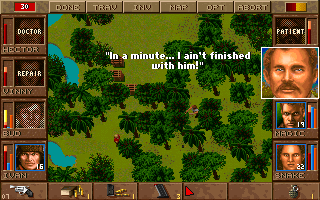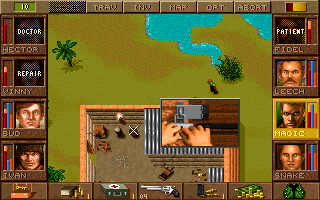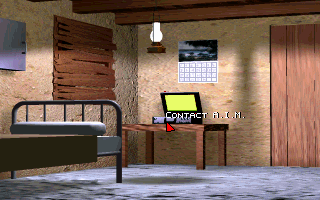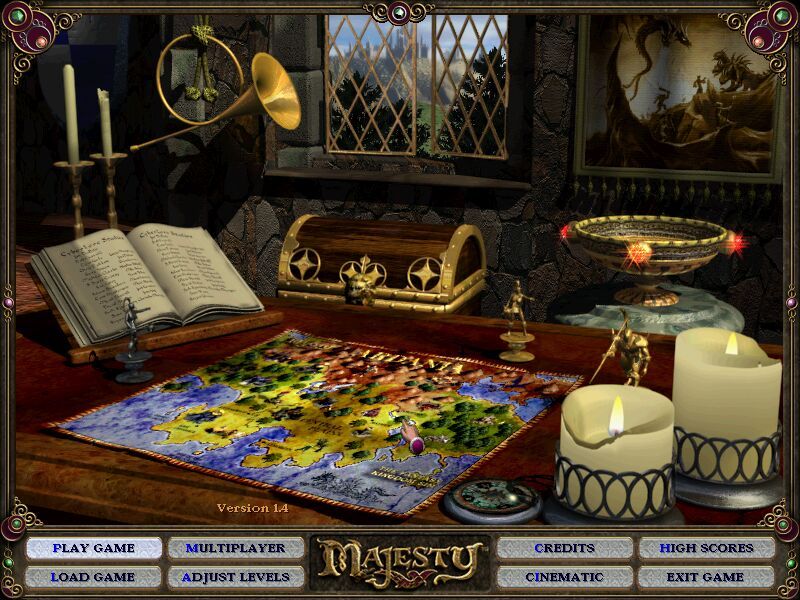MrBuzzKill
Arcane
- Joined
- Aug 31, 2013
- Messages
- 693
In spring 2021 I played and completed Jagged Alliance 1 for the first time. I was impressed with how well it holds up today and randomly decided to look up the people who made it. Most were hard to reach, but fortunately, the person responsible for most of the art and animation in the game - Mohanned (Ned) Mansour - had an online presence so I was able to ask him some questions. The answers were very interesting, especially for anybody into gaming art history. Now I wish I prepared ahead of time... But here it is (interspersed with Mobygames screenshots):
Me: Hi. Sorry, I was wondering: are you the Ned Mansour who worked on the original Jagged Alliance game?
NM: Hi there. Yes, I worked on the original Jagged Alliance. May I ask why you’re asking?
Me: Sorry, I was just curious. I've picked up the game for the first time recently and played it for over 10 hours already. It's very fun! Then decided to look up the people who originally made it, where they are now and what they are doing. Thanks for making a great game!
NM: Wow, thanks for sharing your experience with the game. That was my first experience creating art in games. I started on the project with two other guys, Ian Curry (programmer and director) and Shaun Lyng (writer). I took care of everything from 3d modeling to animation and user interface design. It was the most fun project I ever worked on and funny enough, it was all done remotely. We used dial-up modems to transfer data and we all worked from our own homes. We were a little ahead of the times I guess. Glad you liked it.
Glad you liked it.
I graduated with an animation degree, then I worked as a general artist in games for close to 18 years then tried wedding photography for a while. Then I worked as an character animator in movies for a year and now I’m doing special fx on tv shows.

Me: Very nice! On your Mobygames page, it actually lists the games you worked on, and there are some very well-known titles such as Red Alert 1 and Prince of Persia games. It looks like around 2003 you focused on VFX in games. And then movies and TV as well? It seems you had a hand in a lot of cool projects over the years. Can I ask you what 3D modelling and animation was like for you in the early 90s? I've seen the interfaces and some behind the scenes footage of how they made the original Toy Story, and previewing animation seemed horribly slow to me! lol! It must've been quite a task to model the units and animate them then?
NM: Yes, we were learning as we went. There was no google or youtube back then. I remember learning 3d studio (before it became 3dMax) when it first came out straight from the manuals that came with the software. It was a whole different way of making games as well.
I remember having to make all the different animations of the characters facing various angles and then rendering them from a top-down angle, then placing all the animation keys next to each other in one image which contained all the animations in it. The hardest thing was to limit the color pallet to a small number of colors. The game was limited to 256 colors total. Every color that was in that pallet was thought about very carefully. There were different colors used for the characters, others used for the terrain and others for the interface. We worked on the color pallet for months before we got everything perfectly right for the game. It was like figuring out a puzzle. I really enjoyed doing that because it was always like solving a puzzle. I could go on and on, but it would take too long to explain the process.
I took a look at your post with the pig and butcher. Nice models. Keep up the good work. [this is about my 3D artwork I put up on the site]

Me: Thank you, it means a lot! and thanks for explaining part of the original creative process. Now that you mention the color palette, I notice the characters do clearly stand out against the jungle. It's one of those things a player probably won't think about unless it's done wrong! I like the interface too, especially the player's office with the animated bits (laptop, bed, window, etc) and various panels that move and rotate in the GUI, giving that "physical" feel to the game. I would be interested to learn more (unfortunately couldn't find any interviews regarding the original game, just JA2), but I can appreciate that your time is valuable.

NM: Thanks for the compliment. The animated interface (room) was something I was very proud of at the time. We used a tool called Animator Pro which at the time was one of the best tools to do animations in games. It allowed color palette control and you could toggle back and forth between frames. The room was created in 3ds and then I brought the rendered frames into AP in order to animate the covers for example. That was hard to do in 3d. The rest of the interactive elements in the room were done straight in 3ds. As for all the facial animations, I scanned photos of people and then created animations in Delux Paint which was the main tool I used to create most of the graphics in the game. Forget about Photoshop. I was there at the time but mainly on the mac if I remember correctly, so I did most of the work in DP. I also used a morph program which (the name escapes me at the moment) to create looping fire or explosion animations. Amazingly I learned all of this on my own without any books or videos. I guess when you don’t spend as much time on the internet, you end up with a lot of time to experiment and find solutions for problems.

This is why I love doing fx in video games. It was all about finding creative solutions to do things that appear to be realistic or three dimensional. That part is getting less and less appreciated these days where everything is simulated and fx are getting more and more real and done in real time. I have moved away from games now and I love making fx for tv or movies using tools like Houdini, Maya and Unreal. I get to be creative and come up with tricks to speed up production fx.
I will be turning 52 this year and I still love what I do and still feel like I’m just starting out as an artist. Learning new tools and tricks is a full time job and being passionate about art means I love the whole process of creating art. I hope to get good at what I do one day. Good luck to you my friend and thanks again for making me relive some of those wonderful times in the not too distant past.
Me: I'm struggling to write something clever, so I'll just say thank you again for being so nice and answering my questions! Good luck to you too.
Me: Hi. Sorry, I was wondering: are you the Ned Mansour who worked on the original Jagged Alliance game?
NM: Hi there. Yes, I worked on the original Jagged Alliance. May I ask why you’re asking?
Me: Sorry, I was just curious. I've picked up the game for the first time recently and played it for over 10 hours already. It's very fun! Then decided to look up the people who originally made it, where they are now and what they are doing. Thanks for making a great game!
NM: Wow, thanks for sharing your experience with the game. That was my first experience creating art in games. I started on the project with two other guys, Ian Curry (programmer and director) and Shaun Lyng (writer). I took care of everything from 3d modeling to animation and user interface design. It was the most fun project I ever worked on and funny enough, it was all done remotely. We used dial-up modems to transfer data and we all worked from our own homes. We were a little ahead of the times I guess.
I graduated with an animation degree, then I worked as a general artist in games for close to 18 years then tried wedding photography for a while. Then I worked as an character animator in movies for a year and now I’m doing special fx on tv shows.

Me: Very nice! On your Mobygames page, it actually lists the games you worked on, and there are some very well-known titles such as Red Alert 1 and Prince of Persia games. It looks like around 2003 you focused on VFX in games. And then movies and TV as well? It seems you had a hand in a lot of cool projects over the years. Can I ask you what 3D modelling and animation was like for you in the early 90s? I've seen the interfaces and some behind the scenes footage of how they made the original Toy Story, and previewing animation seemed horribly slow to me! lol! It must've been quite a task to model the units and animate them then?
NM: Yes, we were learning as we went. There was no google or youtube back then. I remember learning 3d studio (before it became 3dMax) when it first came out straight from the manuals that came with the software. It was a whole different way of making games as well.
I remember having to make all the different animations of the characters facing various angles and then rendering them from a top-down angle, then placing all the animation keys next to each other in one image which contained all the animations in it. The hardest thing was to limit the color pallet to a small number of colors. The game was limited to 256 colors total. Every color that was in that pallet was thought about very carefully. There were different colors used for the characters, others used for the terrain and others for the interface. We worked on the color pallet for months before we got everything perfectly right for the game. It was like figuring out a puzzle. I really enjoyed doing that because it was always like solving a puzzle. I could go on and on, but it would take too long to explain the process.
I took a look at your post with the pig and butcher. Nice models. Keep up the good work. [this is about my 3D artwork I put up on the site]

Me: Thank you, it means a lot! and thanks for explaining part of the original creative process. Now that you mention the color palette, I notice the characters do clearly stand out against the jungle. It's one of those things a player probably won't think about unless it's done wrong! I like the interface too, especially the player's office with the animated bits (laptop, bed, window, etc) and various panels that move and rotate in the GUI, giving that "physical" feel to the game. I would be interested to learn more (unfortunately couldn't find any interviews regarding the original game, just JA2), but I can appreciate that your time is valuable.

NM: Thanks for the compliment. The animated interface (room) was something I was very proud of at the time. We used a tool called Animator Pro which at the time was one of the best tools to do animations in games. It allowed color palette control and you could toggle back and forth between frames. The room was created in 3ds and then I brought the rendered frames into AP in order to animate the covers for example. That was hard to do in 3d. The rest of the interactive elements in the room were done straight in 3ds. As for all the facial animations, I scanned photos of people and then created animations in Delux Paint which was the main tool I used to create most of the graphics in the game. Forget about Photoshop. I was there at the time but mainly on the mac if I remember correctly, so I did most of the work in DP. I also used a morph program which (the name escapes me at the moment) to create looping fire or explosion animations. Amazingly I learned all of this on my own without any books or videos. I guess when you don’t spend as much time on the internet, you end up with a lot of time to experiment and find solutions for problems.

This is why I love doing fx in video games. It was all about finding creative solutions to do things that appear to be realistic or three dimensional. That part is getting less and less appreciated these days where everything is simulated and fx are getting more and more real and done in real time. I have moved away from games now and I love making fx for tv or movies using tools like Houdini, Maya and Unreal. I get to be creative and come up with tricks to speed up production fx.
I will be turning 52 this year and I still love what I do and still feel like I’m just starting out as an artist. Learning new tools and tricks is a full time job and being passionate about art means I love the whole process of creating art. I hope to get good at what I do one day. Good luck to you my friend and thanks again for making me relive some of those wonderful times in the not too distant past.
Me: I'm struggling to write something clever, so I'll just say thank you again for being so nice and answering my questions! Good luck to you too.
Last edited:










![Glory to Codexia! [2012] Codex 2012](/forums/smiles/campaign_tags/campaign_slushfund2012.png)


























